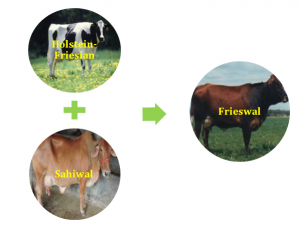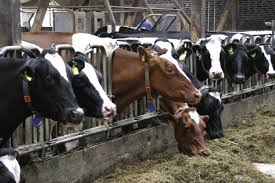Table of Contents
Since time immemorial, animals have been an integral part of our food. They have been used to obtain food like milk, eggs, meat, etc. Other than the food, we use them even for some basic requirements like wool, silk, labour, etc. The population has reached its peak, especially in a country like India. The population explosion has led to greater demand for basic requirements such as food, shelter, clothing, etc. To meet the increasing requirements and demands we need to apply a greater effort. One such effort to meet the food demand is animal husbandry. Animal husbandry includes cattle farming, poultry farming, fisheries, apiculture, etc. Here we will learn about cattle farming.
Animal Husbandry
Animal husbandry is the science of farming animal livestock. It includes caring for, breeding and management of livestock. Animal husbandry is a large-scale business where animals that provide us food are reared, bred, sheltered and cared for in a farm or in regions which are specially built for them. Animal husbandry was initiated with cattle farming. Under cattle farming, livestock such as cows, goats, buffalo, sheep, etc. is reared. Later, animal husbandry was even extended to poultry farming, fisheries, apiculture, etc. And this extends a helping hand to the increasing needs of the generations.
Cattle Farming
Cattle farming involves the rearing and management of two types of animals- one group for food requirements like milk and another for labour purposes like ploughing, irrigation, etc. Animals which provide milk are called milch/dairy animals. For example, goats, buffalo, cows, etc. Animals which are used for labour are called draught animals.
Since dairy animals are cared for and bred for milk, we need to improve milk production to meet the requirements. The period after the birth of a calf, when a cow starts to produce milk, is called the lactation period. We can enhance milk production by increasing this lactation period. But along with milk production, quality must also meet. Dairy farm management is the management of the milch animals with the goal of enhancing the quantity and quality of the milk produced. For this reason, high-yielding and disease-resistant breeds are developed.

Cross-breeding in Cattle Farming
For example, foreign breeds like Jersey, Holstein-Friesian, and Brown Swiss, have long lactation periods while local breeds like Red Sindhi, Sahiwal, and Gir are known for their disease-resistant trait. The breeding of these two varieties helped us to enhance the quantity and quality of the milk produced.
Farm Management
Cattle farming is not all about milk or meat production. It also comes with some responsibilities. To meet human requirements, we need to take good care and need proper management of livestock.
Shelter
In cattle farming, animals are maintained in a strictly hygienic manner with proper housing. For maintenance, we need to follow some routines.
- Animals and their sheds need to be cleaned at regular intervals.
- Animals should be brushed regularly to remove the dirt and bugs in their body.
- The shed should be well-ventilated and roofed so that animals are protected from rain, heat, and cold.
- A proper drainage system should be there to remove animal waste.
Also Read: Fish production
Food
Food requirements of animals are also a part of cattle farming. To maintain high-yielding and disease-resistant breeds, they must be provided with an adequate water supply and nutrient-rich fodder regularly according to their needs. In cattle farming, two factors are considered regarding the food of cattle. The food that is provided must keep the animals healthy as well as should meet the farming requirement. Hence, animal feed includes roughage (high fibre content) and concentrates (high proteins and nutrient content). In addition to this, supplements containing micronutrients are also provided to animals. An adequate proportion of these rations promote healthy and high-output animals.

Disease Management
The third responsibility of cattle farming management is to maintain disease-free breeds. Animals are not an exception to disease. They also suffer from numerous diseases. This may affect the health as well as productivity of animals; even cause their death. Parasites, bacteria, and viruses are the major villains here. These microbes infect the cattle externally as well as internally. Vaccination is the one solution for the protection against bacterial and viral infections.
Frequently Asked Questions:
Q.1. The other name for Splenic fever is
- FMD
- Anthrax
- Cowpox
- Mastitis
A.1. The other name for Splenic fever is Anthrax
Q.2. Name the largest part of the ruminant stomach.
A.2. The largest part of the ruminant stomach is the rumen
Q.3. What is Galactopoiesis?
A.3. The maintenance of milk production is referred to as galactopoiesis. This phase needs prolactin. For the milk let-down reflex to be generated, oxytocin is crucial for the response of suckling. Galactorrhea is the production of milk that is irrelevant to the process of nursing.
Q.4. What are the benefits of cattle farming?
A.4. Listed below are the benefits of cattle farming:
- Milk cattle are extensively used for milk production
- The draught cattle are widely used for the labour in association with streams like agriculture where they are used in carting and irrigation
- The cattle farm is known to increase the overall revenue for the farmers and improves their standard of living
- The animal waste that is produced can be used as a source of manure for soil enrichment and as a source of biofuel.
- It is a source of employment for a huge number of people.
Q.5. Write about the importance of animal husbandry in India.
A.5. Animal husbandry is of paramount importance in India, listed below are some chief points stating its importance:
- It provides livestock production
- It is an indispensable part of the process of crop farming which significantly contributes to the household food security and community nutrition
- Animal husbandry provides some main products such as wool, skin, and mutton that are obtained from the sheep
- Milk is produced by cows, buffaloes, etc
- It provides a means to curb poverty through a rise in the household income
- Crop-farming is formed by an elemental part, the livestock production by participating in poverty elevation via increased income.
Learn more in detail about what is cattle farming, its process, its importance and other related topics at BYJU’S Biology.
Also Read:

Thanks for the good program, l really wish to learn more from you guys
Thank you for the information about the benefits of cattle farming. It was really worth reading your article. Very well written.
Name the two species of cattle used for the purpose of cattle farming.
Cows and Buffaloes are commonly used for dairy products.
This is enlightened notes that teach and educate more in framing specifically animal husbandry.
I like to study